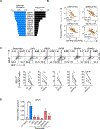Integrated Pan-Cancer Map of EBV-Associated Neoplasms Reveals Functional Host-Virus Interactions
- PMID: 31481499
- PMCID: PMC6891172
- DOI: 10.1158/0008-5472.CAN-19-0615
Integrated Pan-Cancer Map of EBV-Associated Neoplasms Reveals Functional Host-Virus Interactions
Abstract
Epstein-Barr virus (EBV) is a complex oncogenic symbiont. The molecular mechanisms governing EBV carcinogenesis remain elusive and the functional interactions between virus and host cells are incompletely defined. Here we present a comprehensive map of the host cell-pathogen interactome in EBV-associated cancers. We systematically analyzed RNA sequencing from >1,000 patients with 15 different cancer types, comparing virus and host factors of EBV+ to EBV- tissues. EBV preferentially integrated at highly accessible regions of the cancer genome, with significant enrichment in super-enhancer architecture. Twelve EBV transcripts, including LMP1 and LMP2, correlated inversely with EBV reactivation signature. Overexpression of these genes significantly suppressed viral reactivation, consistent with a "virostatic" function. In cancer samples, hundreds of novel frequent missense and nonsense variations in virostatic genes were identified, and variant genes failed to regulate their viral and cellular targets in cancer. For example, one-third of patients with EBV+ NK/T-cell lymphoma carried two novel nonsense variants (Q322X, G342X) of LMP1 and both variant proteins failed to restrict viral reactivation, confirming loss of virostatic function. Host cell transcriptional changes in response to EBV infection classified tumors into two molecular subtypes based on patterns of IFN signature genes and immune checkpoint markers, such as PD-L1 and IDO1. Overall, these findings uncover novel points of interaction between a common oncovirus and the human genome and identify novel regulatory nodes and druggable targets for individualized EBV and cancer-specific therapies. SIGNIFICANCE: This study provides a comprehensive map of the host cell-pathogen interactome in EBV+ malignancies.See related commentary by Mbulaiteye and Prokunina-Olsson, p. 5917.
©2019 American Association for Cancer Research.
Figures






Comment in
-
It Takes Two (Genomes) to Cancer: Paired Viral and Host Transcriptome Analysis Provides New Insights about EBV Carcinogenicity.Cancer Res. 2019 Dec 1;79(23):5917-5919. doi: 10.1158/0008-5472.CAN-19-2996. Cancer Res. 2019. PMID: 31791960
Comment on
-
It Takes Two (Genomes) to Cancer: Paired Viral and Host Transcriptome Analysis Provides New Insights about EBV Carcinogenicity.Cancer Res. 2019 Dec 1;79(23):5917-5919. doi: 10.1158/0008-5472.CAN-19-2996. Cancer Res. 2019. PMID: 31791960
References
-
- IARC Working Group. IARC monographs on the evaluation of carcinogenic risks to humans Volume 100B: Biological agents. Lyon, France: IARC : Distributed for the International Agency for Research on Cancer by the Secretariat of the World Health Organization; 2012. p volumes.
-
- Kutok JL, Wang F. Spectrum of Epstein-Barr virus-associated diseases. Annu Rev Pathol 2006;1:375–404 - PubMed
Publication types
MeSH terms
Grants and funding
LinkOut - more resources
Full Text Sources
Research Materials

